美国加州二年级的科学标准
- 格式:doc
- 大小:102.00 KB
- 文档页数:13

各国小学科学课程内容标准的比较作者:常初芳目前手头具有的完整的科学教育标准有:美国的《国家科学教育标准(National Science Education Standards)》和2061项目的《科学素养的基准(Benchmarks for Science Literacy)》;英国的《英国国家课程:科学(The National Curriculum for England: science)》;以及新西兰的《新西兰课程中的科学(Science in the New Zealand Curriculum)。
另外,还有其它一些国家或地区的参考资料,如澳大利亚新南威尔士的《幼儿园至6年级科技课大纲及支持文件(Science and Technology K-6 Syllabus and Support Document)》,《俄罗斯十二年制学校自然科学教育构想》,《日本小学理科学习指导要领》,《台湾九年一贯教育课程总纲纲要及其评价》等。
从对上述材料的分析可看出,当前小学科学课程内容主要可归纳为以下几个方面:●科学探究;●基本学科知识;●与个人和社会密切相关的科学问题;●科学的性质、科学与技术,以及科学史;●其它。
一、科学探究这已成为当今科学教育最重要的内容,在美国和英国的标准中都被放在最醒目的位置。
美国《国家科学教育标准》对科学探究的解释为:在《标准》所表达的观念中,探究要比“过程的科学”更进了一步。
在“过程的科学”中,学生学习观察、推论和实验,而探究除了“科学的过程”外,还要求学生在进行科学论证和批判性思维时能将过程和科学知识相结合,以发展对科学的理解。
让学生参与探究可以帮助学生发展:●对科学概念的理解;●对获得科学知识方法的欣赏;●对科学本质的理解;●对自然界进行独立探究的必要技能;●具备善于运用与科学有关的技能、能力和态度的品质。
探究的科学是科学教育的根本,是最终组织和选取学生活动的支配原则。
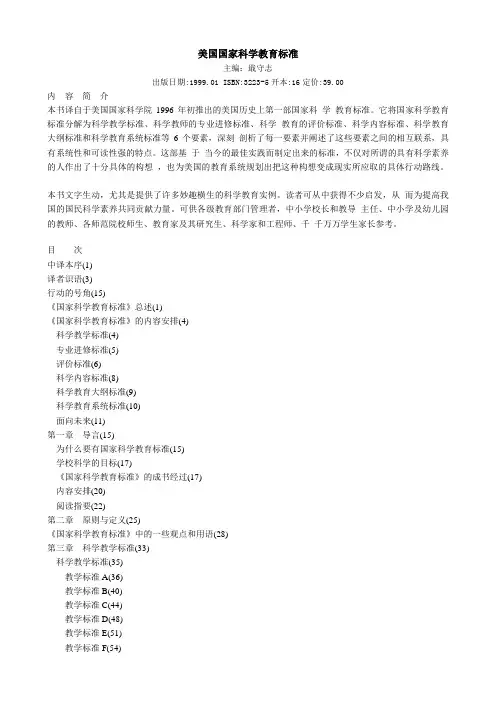
美国国家科学教育标准主编:戢守志出版日期:1999.01 ISBN:3223-5开本:16定价:39.00内容简介本书译自于美国国家科学院1996年初推出的美国历史上第一部国家科学教育标准。
它将国家科学教育标准分解为科学教学标准、科学教师的专业进修标准、科学教育的评价标准、科学内容标准、科学教育大纲标准和科学教育系统标准等6个要素,深刻剖析了每一要素并阐述了这些要素之间的相互联系,具有系统性和可读性强的特点。
这部基于当今的最佳实践而制定出来的标准,不仅对所谓的具有科学素养的人作出了十分具体的构想,也为美国的教育系统规划出把这种构想变成现实所应取的具体行动路线。
本书文字生动,尤其是提供了许多妙趣横生的科学教育实例。
读者可从中获得不少启发,从而为提高我国的国民科学素养共同贡献力量。
可供各级教育部门管理者,中小学校长和教导主任、中小学及幼儿园的教师、各师范院校师生、教育家及其研究生、科学家和工程师、千千万万学生家长参考。
目次中译本序(1)译者识语(3)行动的号角(15)《国家科学教育标准》总述(1)《国家科学教育标准》的内容安排(4)科学教学标准(4)专业进修标准(5)评价标准(6)科学内容标准(8)科学教育大纲标准(9)科学教育系统标准(10)面向未来(11)第一章导言(15)为什么要有国家科学教育标准(15)学校科学的目标(17)《国家科学教育标准》的成书经过(17)内容安排(20)阅读指要(22)第二章原则与定义(25)《国家科学教育标准》中的一些观点和用语(28)第三章科学教学标准(33)科学教学标准(35)教学标准A(36)教学标准B(40)教学标准C(44)教学标准D(48)教学标准E(51)教学标准F(54)教学重点的改变(56)第四章科学教师专业进修标准(71)科学教师专业进修标准(75)专业进修标准A(75)专业进修标准B(79)专业进修标准C(84)专业进修标准D(87)专业进修重点的改变(89)第五章科学教育中的评价(95)科学教育评价标准(98)评价标准A(98)评价标准B(99)评价标准C(101)评价标准D(103)评价标准E(104)由任课教师进行的评价(105)改进课堂教学实践(105)制定课程计划(105)培养自学能力(106)报告学生的进步(107)教学实践的研究(108)学区、州和国家级评价(108)数据分析(109)教师的参与(109)样本大小(109)样本的代表性(109)学生科学成绩评价示例(110)评价对自然界的理解(110)评价探究能力(118)评价重点的改变(121)第六章科学内容标准(125)设立依据(125)统一的概念和过程之标准(126)作为探究过程的科学之标准(127)物质科学、生命科学及地球与空间科学之标准(128)科学与技术之标准(129)从个人和社会视角所见的科学之标准(130)科学的历史和本质之标准(131)内容标准的形式(131)内容标准的检验尺度(132)内容标准的用途(134)内容重点的改变(137)从幼儿园到12年级的内容标准(139)统一的概念和过程(139)从幼儿园到4年级的内容标准(145)作为探究的科学(145)物质科学(147)生命科学(151)地球和空间科学(154)科学与技术(156)从个人和社会视角所见的科学(159)科学的历史和本质(163)5~8年级的内容标准(175)作为探究的科学(175)物质科学(179)生命科学(182)地球和空间科学(186)科学与技术(189)从个人和社会视角所见的科学(192)科学的历史和本质(197)9~12年级的内容标准(213)作为探究对象的科学(213)物质科学(217)生命科学(222)地球与空间科学(228)科学与技术(231)从个人和社会视角所见的科学(235)科学的历史和本质(239)第七章科学教育大纲标准(253)科学教育大纲标准(253)大纲标准A(254)大纲标准B(255)大纲标准C(258)大纲标准D(259)大纲标准E(262)大纲标准F(263)大纲重点的改变(265)第八章科学教育系统标准(271)科学教育系统标准(274)系统标准A(274)系统标准B(275)系统标准C(275)系统标准D(276)系统标准E(277)系统标准F(277)系统标准G(277)系统重点的改变(280)结束语(287)《美国国家科学教育标准》——第一章《国家科学教育标准》是为引导我国国民步入一个具有高度科学素养的社会而撰写的。
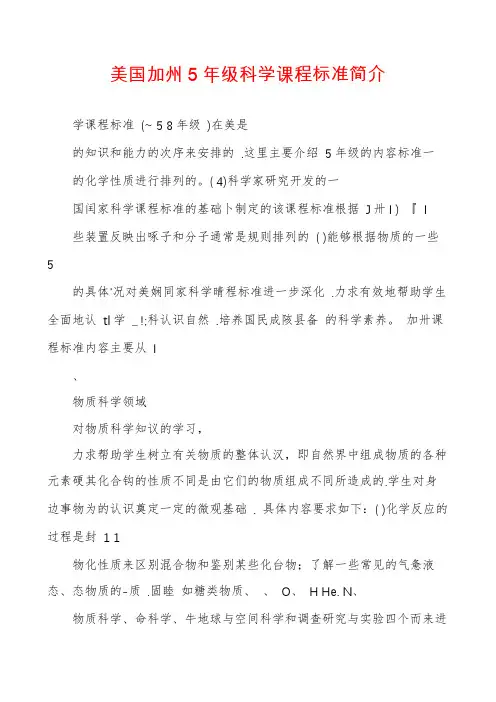
美国加州5年级科学课程标准简介学课程标准(~ 5 8年级)在美是的知识和能力的次序来安排的 .这里主要介绍5年级的内容标准一的化学性质进行排列的。
( 4)科学家研究开发的一国闰家科学课程标准的基础卜制定的该课程标准根据J卅I ) 『I些装置反映出啄子和分子通常是规则排列的( )能够根据物质的一些5的具体’况对美娴同家科学晴程标准进一步深化 .力求有效地帮助学生全面地认tl学_ !;科认识自然 .培养国民成陔县备的科学素养。
加卅课程标准内容主要从I、物质科学领域对物质科学知议的学习,力求帮助学生树立有关物质的整体认汉,即自然界中组成物质的各种元素硬其化合钩的性质不同是由它们的物质组成不同所造成的.学生对身边事物为的认识奠定一定的微观基础 . 具体内容要求如下:( )化学反应的过程是封 1 1物化性质来区别混合物和鉴别某些化台物;了解一些常见的气惫液态、态物质的-质 .固睦如糖类物质、、O、H He. N、物质科学、命科学、牛地球与空间科学和调查研究与实验四个而来进行表述,对学生学的内容和能力,掇出r详细而体的婴求标准虽然是从C2 O等( ) r解具有生命活性的6物体和自然界中的大多数原料都是由较少种类的元素缴成的,能够了解盐的共同性质,并如Na I C.成反臆物的原于发生重组 .形成了具有不同性质的新物质f 2)一叼金倩皆由原于构个『的而米进,彳表述,f lJ巾每一项容标准郜两盖普∈各个领域的知纵和技能 .怀的山容之问相互联系、相渗透,彤l厂、{的学科体成1宪l薹系。
二、生命科学领域成.原子组合形成分子,了解金属具有相同属性知强导电性导热;知道金属可分为两类:纯金属和台金:了解其组成上的同并能够州举相应的例子牛命科学的内容则屉剂助学生认识到自然界中的各种动植物都是通过自身所具有的栖庖结构来进行各种生命活动的 .从晰对自然界的生命现象针埘不同学习阶段的学生,科学课程内容标准的侧重有一定的认识。
具体内容涉及( ) r衅元素的概念及无3到:点也同,内容标准的结构是2 0 1 a棚0 5牟『1维普资讯( )很多细胞生物体都具1( )知道太阳是宇宙中一3颗普通的恒星,是太阳系中最论,并说明得出一个具体的结有自身的特殊结构来进行体内的物质运输。
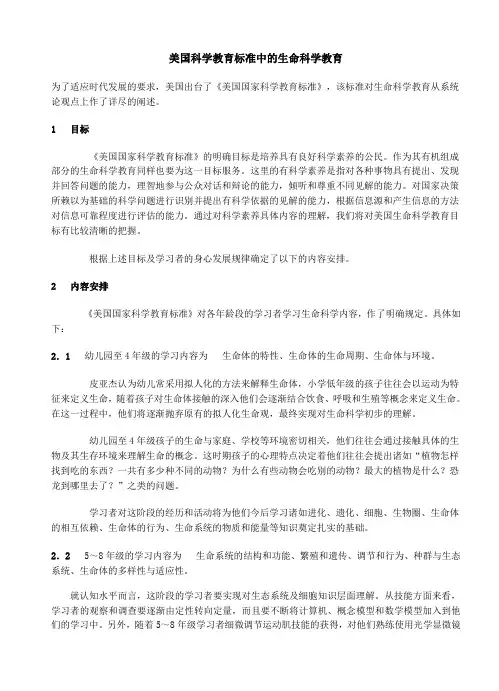
美国科学教育标准中的生命科学教育为了适应时代发展的要求,美国出台了《美国国家科学教育标准》,该标准对生命科学教育从系统论观点上作了详尽的阐述。
1 目标《美国国家科学教育标准》的明确目标是培养具有良好科学素养的公民。
作为其有机组成部分的生命科学教育同样也要为这一目标服务。
这里的有科学素养是指对各种事物具有提出、发现并回答问题的能力,理智地参与公众对话和辩论的能力,倾听和尊重不同见解的能力。
对国家决策所赖以为基础的科学问题进行识别并提出有科学依据的见解的能力,根据信息源和产生信息的方法对信息可靠程度进行评估的能力。
通过对科学素养具体内容的理解,我们将对美国生命科学教育目标有比较清晰的把握。
根据上述目标及学习者的身心发展规律确定了以下的内容安排。
2 内容安排《美国国家科学教育标准》对各年龄段的学习者学习生命科学内容,作了明确规定。
具体如下:2.1 幼儿园至4年级的学习内容为生命体的特性、生命体的生命周期、生命体与环境。
皮亚杰认为幼儿常采用拟人化的方法来解释生命体,小学低年级的孩子往往会以运动为特征来定义生命,随着孩子对生命体接触的深入他们会逐渐结合饮食、呼吸和生殖等概念来定义生命。
在这一过程中,他们将逐渐抛弃原有的拟人化生命观,最终实现对生命科学初步的理解。
幼儿园至4年级孩子的生命与家庭、学校等环境密切相关,他们往往会通过接触具体的生物及其生存环境来理解生命的概念。
这时期孩子的心理特点决定着他们往往会提出诸如“植物怎样找到吃的东西?一共有多少种不同的动物?为什么有些动物会吃别的动物?最大的植物是什么?恐龙到哪里去了?”之类的问题。
学习者对这阶段的经历和活动将为他们今后学习诸如进化、遗化、细胞、生物圈、生命体的相互依赖、生命体的行为、生命系统的物质和能量等知识奠定扎实的基础。
2.2 5~8年级的学习内容为生命系统的结构和功能、繁殖和遗传、调节和行为、种群与生态系统、生命体的多样性与适应性。
就认知水平而言,这阶段的学习者要实现对生态系统及细胞知识层面理解。
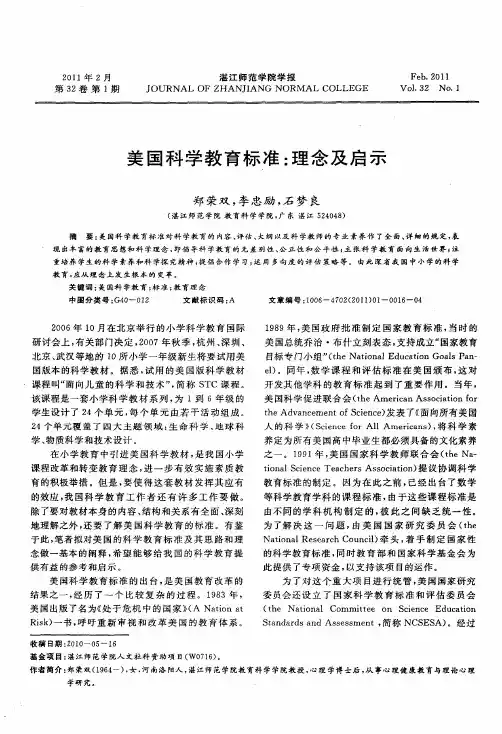
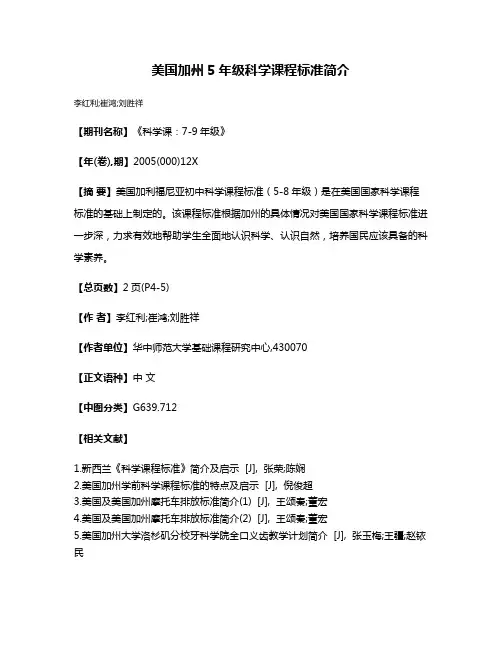
美国加州5年级科学课程标准简介
李红利;崔鸿;刘胜祥
【期刊名称】《科学课:7-9年级》
【年(卷),期】2005(000)12X
【摘要】美国加利福尼亚初中科学课程标准(5-8年级)是在美国国家科学课程标准的基础上制定的。
该课程标准根据加州的具体情况对美国国家科学课程标准进一步深,力求有效地帮助学生全面地认识科学、认识自然,培养国民应该具备的科学素养。
【总页数】2页(P4-5)
【作者】李红利;崔鸿;刘胜祥
【作者单位】华中师范大学基础课程研究中心,430070
【正文语种】中文
【中图分类】G639.712
【相关文献】
1.新西兰《科学课程标准》简介及启示 [J], 张荣;陈娴
2.美国加州学前科学课程标准的特点及启示 [J], 倪俊超
3.美国及美国加州摩托车排放标准简介(1) [J], 王颂秦;董宏
4.美国及美国加州摩托车排放标准简介(2) [J], 王颂秦;董宏
5.美国加州大学洛杉矶分校牙科学院全口义齿教学计划简介 [J], 张玉梅;王疆;赵铱民
因版权原因,仅展示原文概要,查看原文内容请购买。

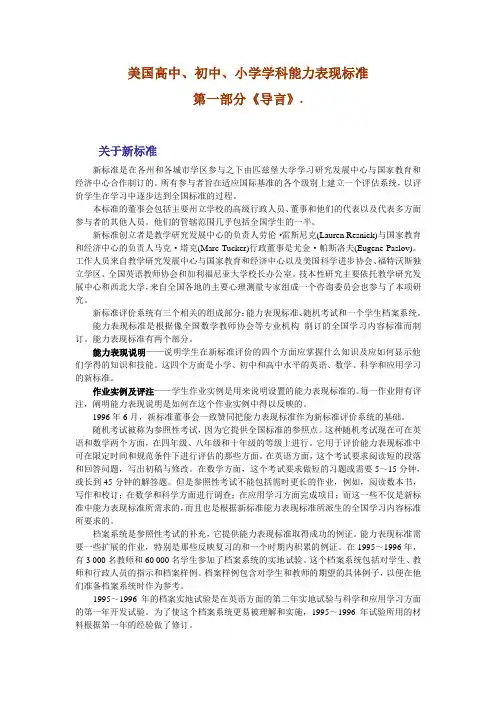
美国高中、初中、小学学科能力表现标准第一部分《导言》.关于新标准新标准是在各州和各城市学区参与之下由匹兹堡大学学习研究发展中心与国家教育和经济中心合作制订的。
所有参与者旨在适应国际基准的各个级别上建立一个评估系统,以评价学生在学习中逐步达到全国标准的过程。
本标准的董事会包括主要州立学校的高级行政人员、董事和他们的代表以及代表多方面参与者的其他人员。
他们的管辖范围几乎包括全国学生的一半。
新标准创立者是教学研究发展中心的负责人劳伦·雷斯尼克(Lauren Resnick)与国家教育和经济中心的负责人马克·塔克(Marc Tucker)行政董事是尤金·帕斯洛夫(Eugene Paslov)。
工作人员来自教学研究发展中心与国家教育和经济中心以及美国科学进步协会、福特沃斯独立学区、全国英语教师协会和加利福尼亚大学校长办公室。
技本性研究主要依托教学研究发展中心和西北大学,来自全国各地的主要心理测量专家组成一个咨询委员会也参与了本项研究。
新标准评价系统有三个相关的组成部分:能力表现标准、随机考试和一个学生档案系统。
能力表现标准是根据像全国数学教师协会等专业机构制订的全国学习内容标准而制订。
能力表现标准有两个部分。
能力表现说明——说明学生在新标准评价的四个方面应掌握什么知识及应如何显示他们学得的知识和技能。
这四个方面是小学、初中和高中水平的英语、数学、科学和应用学习的新标准。
作业实例及评注——学生作业实例是用来说明设置的能力表现标准的。
每一作业附有评注,阐明能力表现说明是如何在这个作业实例中得以反映的。
1996年6月,新标准董事会一致赞同把能力表现标准作为新标准评价系统的基础。
随机考试被称为参照性考试,因为它提供全国标准的参照点。
这种随机考试现在可在英语和数学两个方面,在四年级、八年级和十年级的等级上进行。
它用于评价能力表现标准中可在限定时间和规范条件下进行评估的那些方面。
在英语方面,这个考试要求阅读短的段落和回答问题,写出初稿与修改。
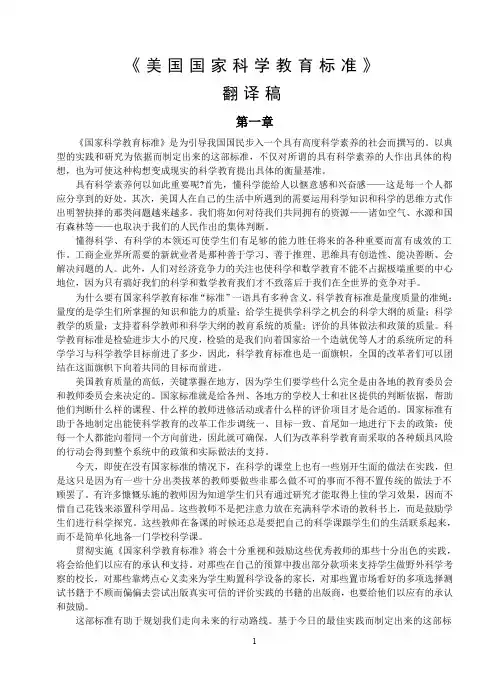
《美国国家科学教育标准》翻译稿第一章《国家科学教育标准》是为引导我国国民步入一个具有高度科学素养的社会而撰写的。
以典型的实践和研究为依据而制定出来的这部标准,不仅对所谓的具有科学素养的人作出具体的构想,也为可使这种构想变成现实的科学教育提出具体的衡量基准。
具有科学素养何以如此重要呢?首先,懂科学能给人以惬意感和兴奋感——这是每一个人都应分享到的好处。
其次,美国人在自己的生活中所遇到的需要运用科学知识和科学的思维方式作出明智抉择的那类问题越来越多。
我们将如何对待我们共同拥有的资源——诸如空气、水源和国有森林等——也取决于我们的人民作出的集体判断。
懂得科学、有科学的本领还可使学生们有足够的能力胜任将来的各种重要而富有成效的工作。
工商企业界所需要的新就业者是那种善于学习、善于推理、思维具有创造性、能决善断、会解决问题的人。
此外,人们对经济竞争力的关注也使科学和数学教育不能不占据极端重要的中心地位,因为只有搞好我们的科学和数学教育我们才不致落后于我们在全世界的竞争对手。
为什么要有国家科学教育标准“标准”一语具有多种含义。
科学教育标准是量度质量的准绳:量度的是学生们所掌握的知识和能力的质量;给学生提供学科学之机会的科学大纲的质量;科学教学的质量;支持着科学教师和科学大纲的教育系统的质量;评价的具体做法和政策的质量。
科学教育标准是检验进步大小的尺度,检验的是我们向着国家给一个造就优等人才的系统所定的科学学习与科学教学目标前进了多少,因此,科学教育标准也是一面旗帜,全国的改革者们可以团结在这面旗帜下向着共同的目标而前进。
美国教育质量的高低,关键掌握在地方,因为学生们要学些什么完全是由各地的教育委员会和教师委员会来决定的。
国家标准就是给各州、各地方的学校人士和社区提供的判断依据,帮助他们判断什么样的课程、什么样的教师进修活动或者什么样的评价项目才是合适的。
国家标准有助于各地制定出能使科学教育的改革工作步调统一、目标一致、首尾如一地进行下去的政策:使每一个人都能向着同一个方向前进,因此就可确保,人们为改革科学教育而采取的各种颇具风险的行动会得到整个系统中的政策和实际做法的支持。
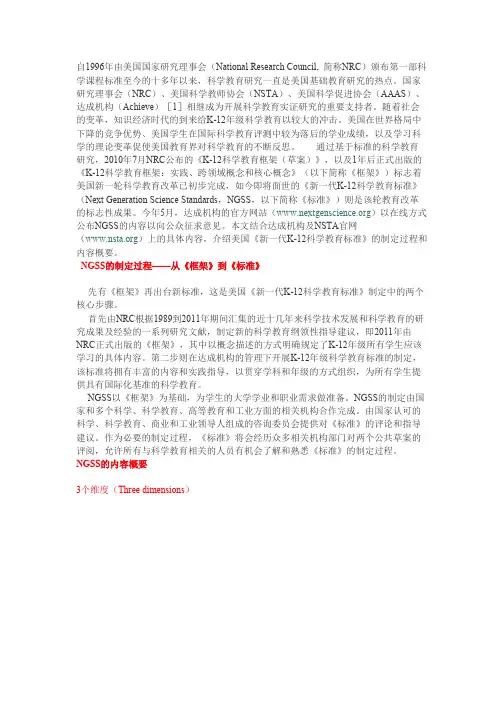
自1996年由美国国家研究理事会(National Research Council, 简称NRC)颁布第一部科学课程标准至今的十多年以来,科学教育研究一直是美国基础教育研究的热点。
国家研究理事会(NRC)、美国科学教师协会(NSTA)、美国科学促进协会(AAAS)、达成机构(Achieve)[1]相继成为开展科学教育实证研究的重要支持者。
随着社会的变革,知识经济时代的到来给K-12年级科学教育以较大的冲击。
美国在世界格局中下降的竞争优势、美国学生在国际科学教育评测中较为落后的学业成绩,以及学习科学的理论变革促使美国教育界对科学教育的不断反思。
通过基于标准的科学教育研究,2010年7月NRC公布的《K-12科学教育框架(草案)》,以及1年后正式出版的《K-12科学教育框架:实践、跨领域概念和核心概念》(以下简称《框架》)标志着美国新一轮科学教育改革已初步完成,如今即将面世的《新一代K-12科学教育标准》(Next Generation Science Standards,NGSS,以下简称《标准》)则是该轮教育改革的标志性成果。
今年5月,达成机构的官方网站()以在线方式公布NGSS的内容以向公众征求意见。
本文结合达成机构及NSTA官网()上的具体内容,介绍美国《新一代K-12科学教育标准》的制定过程和内容概要。
NGSS的制定过程——从《框架》到《标准》先有《框架》再出台新标准,这是美国《新一代K-12科学教育标准》制定中的两个核心步骤。
首先由NRC根据1989到2011年期间汇集的近十几年来科学技术发展和科学教育的研究成果及经验的一系列研究文献,制定新的科学教育纲领性指导建议,即2011年由NRC正式出版的《框架》,其中以概念描述的方式明确规定了K-12年级所有学生应该学习的具体内容。
第二步则在达成机构的管理下开展K-12年级科学教育标准的制定,该标准将拥有丰富的内容和实践指导,以贯穿学科和年级的方式组织,为所有学生提供具有国际化基准的科学教育。
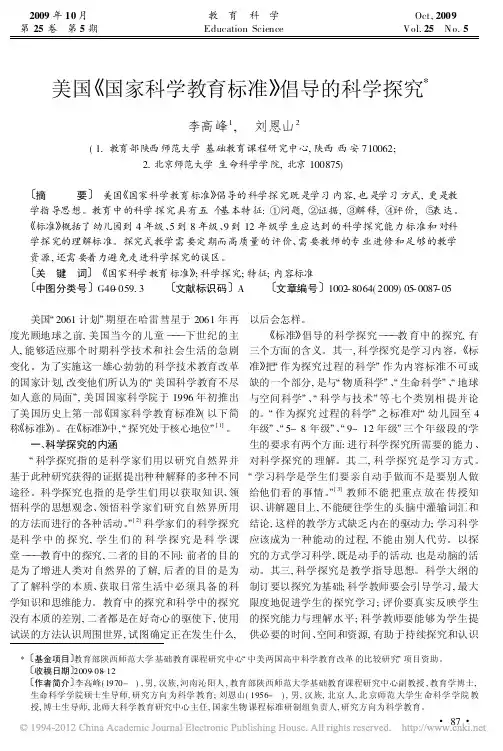
小学二年级科学课程标准自从小学开始,科学课程就成为了孩子们学习中不可或缺的一部分。
科学课程的目标是通过培养兴趣和理解,提高学生们对自然界和科学知识的认识。
在小学二年级科学课程标准中,我们将重点关注以下几个方面。
一、科学观察和实验能力的培养在小学二年级科学课程中,我们鼓励学生通过观察和实验,培养他们的科学思维和实践能力。
学生们将学会用准确的语言描述观察到的现象,并能提出假设并进行简单的实验验证。
例如,在学习天气变化时,学生们可以观察云朵的形状、颜色和移动方式,了解云朵的不同特征与天气之间的关系。
同时,他们也可以自己动手制作简单的气象仪器,如温度计、风向标等,以更好地观察和记录天气变化。
二、生物多样性的认识小学二年级科学课程中,我们希望学生能够了解和认识生物的基本特征,并初步认识生物的多样性。
通过课程的学习,学生们可以认识到生物的分类,了解各类动植物的特点和生活习性。
举例来说,在学习动物的多样性时,学生们可以了解不同种类的动物,如哺乳动物、鸟类、昆虫等,它们的外貌特征和生活环境。
学生们还可以观察和比较不同动物的生活习性,了解它们之间的差异。
三、物质的性质和变化小学二年级科学课程中,我们也将学习物质的性质和变化。
学生们将了解物质的一些基本性质,如颜色、形状、硬度等,并能够通过简单的实验观察物质在不同条件下的变化。
例如,在学习水的性质和变化时,学生们可以进行简单的实验,观察水的沸腾、凝固等现象,并了解其中的科学原理。
学生们还可以通过实验,观察不同物质在水中的溶解情况,了解物质之间的相互作用。
四、环境保护与可持续发展小学二年级科学课程中,我们也注重学生对环境保护和可持续发展问题的认识。
通过学习,学生们将了解到人类与环境的关系,以及保护环境的重要性。
例如,在学习节约用水的时候,学生们可以了解水是一种宝贵的资源,应该节约使用,并了解节约用水的方法。
学生们还可以了解到一些简单的环保行动,如垃圾分类、植树造林等,以促进可持续发展。
第二章《国家科学教育标准》中的探究教育工作者看到或听到“探究”这个词,大都会想到科学教育中一种特殊的教与学的方法。
尽管这是探究的一种重要的应用,但《标准》中所论述的探究则更为基本。
它的内容不仅包含从事探究的能力,还包含如何理解探究本身以及探究何以能导致科学发现。
鉴于探究的重要性,在描述所有学生需要掌握哪些知识与能力的内容标准中,自然包括了科学探究的标准。
这些探究标准详细说明了进行探究所需要的能力与认识,这些认识将有助于学生把探究理解为获取知识的途径。
因此,《标准》旨在让学生懂得人类已有的知识是如何获得的以及什么样的证据能够支持我们的认识。
探究的能力以及对探究的理解不可能凭空产生。
探究与科学问题紧密相联──学生需要运用他们已掌握的知识进行探究,并且在探究过程中增长知识。
那位地质学家在调查造成太平洋沿岸西洋杉林枯死的原因时,就是运用自身的科学知识和探究能力对这一现象产生的原因作出了解释。
格瑞哈姆女士所教的五年级学生通过观察植物和收集有关资料发现了校园中影响树木生长的因素,从而解决了“三棵树难题”。
无论是科学家还是学生的探究活动都是探究与学科知识相互结合融为一体的。
他们通过对自然世界的观察与研究,建立起新的理解从而深化了自身的科学知识。
那么,探究在教育中是如何定义的呢?《标准》指出:“探究是一个多侧面的活动,需要做观察;需要提问题;需要查阅书刊及其它信息源以便弄清什么情况已经是为人所知的东西;需要设计调研方案;需要根据实验证据来检验已经为人所知的东西;需要运用各种手段来搜集、分析和解读数据;需要提出答案、解释和预测;需要把结果告之于人。
探究需要明确假设,需要运用判断思维和逻辑思维,需要考虑可能的其他解释。
”(P23/P30) 发展理解和从事这种活动的能力,要求有直接参与探究的经验和连续的实践。
简单地学习诸如“假设”、“推论”这样的术语或者记忆诸如“科学方法的步骤”这样的程序,学生不可能理解探究。
他们必须从直接参与探究的体验中获得对探究特征的深刻认识。
ngss课程标准
NGSS是“Next Generation Science Standards”(下一代科学标准)的缩写,是指美国教育部发布的针对K-12阶段科学教育的新
一代标准,于2013年正式发布实施。
NGSS标准主要有三个方面的内容:
1.科学范畴和核心概念:涉及到物理学、化学、生物学、地球
科学和工程设计等科学领域。
2.科学实践和工程设计过程:通过科学实践中的探究、建模、
设计和分析,帮助学习者发展成为科学家和工程师。
3.跨学科思考技能:要求学生在科学研究中发展出科学思维、
数学思维和文科思维等跨学科思考技能,帮助他们更好地解决现实问题。
NGSS标准的实施,对于推动美国科技创新和提升学生的创新
能力和竞争力具有重要意义。
ngss课程标准(一)NGSS课程标准简介NGSS是Next Generation Science Standards(下一代科学教育标准)的缩写,是美国制定的新一代科学教育标准。
这些标准于2013年发布,其内容包含了对K-12阶段学生的科学学习要求。
NGSS标准的重要性NGSS标准的制定,旨在提高学生对科学的理解和学习效果,培养学生的科学素养和实验能力,使其能够更好地适应未来社会变革的需要。
NGSS标准的通过,不仅意味着美国科学教育的更新,同时也影响着全球的科学教育。
NGSS标准的内容NGSS标准侧重于以下三个方面:学科核心想法NGSS标准将学科知识划分为四个领域:物理学、生命科学、地球和空间科学、工程技术和应用科学。
其中包含了学生需要掌握的学科核心想法。
多重实践技能NGSS标准重视学生的实践能力,提出了多重实践技能的要求,包括问问题、设计实验、分析数据、解释论据等。
交叉概念NGSS标准认为科学知识不能孤立存在,需要将科学学习与历史、技术、工程等其他学科进行交叉整合。
因此,NGSS标准提出了许多交叉概念的要求。
NGSS标准的实施美国的许多州已经开始将NGSS标准应用于课堂教学中,并且正在逐渐进行推广。
NGSS标准的应用使教师们在教学过程中更加注重学生的实践能力,重视科学与其他学科的整合,帮助学生更好地掌握科学知识。
总结NGSS标准的制定与推广,是美国科学教育领域的一次重要的变革。
NGSS标准中所提出的学科核心想法、多重实践技能和交叉概念等要求,为学生的科学学习提供了更为全面的指导。
同时也为全球科学教育领域提供了有益的借鉴。
NGSS标准带来的机遇和挑战NGSS标准的推广不仅带来了众多机遇,如提高学生的科学素养、培养学生的实践能力等,也面临着一些挑战。
教师角色的变化NGSS标准旨在培养学生的实践能力和探究精神,这意味着教师的角色不再局限于传授知识,而需要变为学生的引导者、合作者,引导学生进行探究和实验。
“There can be no doubt that scientific literacy . . .is now more important than ever before.‖—“A Nation at Risk Revisited‖ToGlenn Theodore SeaborgBorn: April 19, 1912, Ishpeming, MichiganDied: February 25, 1999, Lafayette, CaliforniaGlenn Theodore Seaborg was instrumental in thedesign and development of the Science ContentStandards. Dr. Seaborg was one of the foremost scien-tific minds of the twentieth century, and his legacy iswithout parallel:•Research scientist, discoverer of countless atomicisotopes and ten elements, including plutoniumand the element that bears his name, seaborgium,and formulator of the ―actinide concept‖ of heavyelement electronic structure, one of the most sig-nificant changes in the periodic table of elementssince Mendeleev’s nineteenth-century design•Chairman of the U.S. Atomic Energy Commissionunder presidents Kennedy, Johnson, and Nixon•Cofounder of the Lawrence Hall of Science,Berkeley•Recipient of the Nobel Prize in chemistry•Member of President Reagan’s National Commission on Excellence in Education•Recipient of the National Medal of Science•Chairman, Science Committee, California Commission for the Establishment of Academic Contentand Performance StandardsThe vitality of a democracy assumes a certain“core of knowledge‖ shared by everyone whichserves as a unifying force. It is fundamental to theeffectiveness of our democratic system that ourcitizens be able to make informed judgments onthe more and more complex issues of scientificand technological public policy.—“A Nation at Risk Revisited‖iii California Department of Education Reposted June 11, 2009ContentsA Message from the State Board of Education and the State Superintendentof Public Instruction (vi)Introduction (vii)Kindergarten (1)Grade One (3)Grade Two (5)Grade Three (8)Grade Four (11)Grade Five (14)Grade Six (18)Grade Seven (22)Grade Eight (26)Grades Nine Through Twelve (31)v California Department of Education Reposted June 11, 2009A Message from the State Board of Education and theState Superintendent of Public InstructionIn 1998 California adopted academically rigorouscontent standards in science. The adoption of stan-dards in each core subject area marked a turning pointin the education reform movement that began in 1983with the report A Nation at Risk: The Imperative forEducational Reform, by the National Commission onExcellence in Education. Until then, the reformmovement had focused on important but largelystructural improvements, such as more instructionaltime, minimum course requirements for high schooldiplomas, and an emphasis on local planning efforts topromote efficiency and effectiveness. The desire toimprove student achievement was there, but the focuson content—that is, a comprehensive, specific visionof�what students actually needed to know and be ableto do—was lacking.Standards are a bold initiative.Through content standards in the core subjects,California began to redefine the state’s role in publiceducation. For the first time, the knowledge and skillsthat students needed to acquire were explicitly statedfor the most part by grade level, although sciencestandards at the high school level were organized bydiscipline. The standards are rigorous. Students whomaster this content are on a par with those in the besteducational systems in other states and nations. Thecontent is attainable by all students, given sufficienttime, except for those few who have severe disabilities.We continue to regard the standards as firm but notunyielding; they will be modified in future years toreflect new research and scholarship.Standards describe what to teach,not how to teach it.Standards-based education maintains California’stradition of respect for local control of schools. To helpstudents achieve at high levels, local educators—withthe full support and cooperation of families, busi-nesses, and community partners—have taken thesestandards and designed the specific curricular andinstructional strategies that best deliver the content totheir students. Their efforts have been admirable.Standards are here to stay.Since the science content standards were adopted,much has been done to align all of the state’s effortsin curriculum, instruction, assessment, teacherpreparation, and professional development to thestandards. Educators now see these science contentstandards as the foundation for their work, not as anadditional layer.Standards are a continuing commitmentto excellence.The adoption of science content standards andthe work to align the whole of the educational systemto them have placed our state on the path to successin science education. The standards have broughtcertainty of knowledge and purpose to all. They arecomprehensive and specific. They reflect our continu-ing commitment to excellence.REED HASTINGSPresident, State Board of EducationJACK O’CONNELLState Superintendent of Public InstructionJUNE 2003vi California Department of Education Reposted June 11, 2009Introduction The Science Content Standards for CaliforniaPublic Schools, Kindergarten Through GradeTwelve represents the content of scienceeducation and includes the essential skillsand knowledge students will need to bescientifically literate citizens in the twentyfirst century. By adopting these standards, the State Board of Education affirms itscommitment to provide a world-class scienceeducation for all California students. Thesestandards reflect the diligent work andcommitment of the Commission for theEstablishment of Academic Content andPerformance Standards (Academic StandardsCommission) and the commission’s ScienceCommittee to define the common academiccontent of science education at every gradelevel.Glenn T. Seaborg, one of the great scien-tific minds of this time and of all times,chaired the Academic Standards Commis-sion’s Science Committee. In ―A Letter to aYoung Scientist,‖ Dr. Seaborg said, ―Scienceis an organized body of knowledge and amethod of proceeding to an extension of thisknowledge by hypothesis and experiment.‖1The National Science Education Standardsreflects this view of science and the balancebetween the ―body of knowledge‖ and the“method‖ of scientific inquiry.2The stan-1Gifted Young in Science: Potential Through Performance.Edited by Paul Brandwein and others. Arlington, Va.:National Science Teachers Association, 1989.2National Academy of Sciences, National Science EducationStandards. Washington, D.C.: National Academy of Sciences,1995.dards provide the opportunity to makesubstantial and significant improvements inCalifornia’s education system.The standards include grade-level specificcontent for kindergarten through grade eight.A significant feature is the focus on earthsciences in the sixth grade, life sciences in theseventh grade, and physical sciences in theeighth grade. The standards for grades ninethrough twelve are divided into four contentstrands: physics, chemistry, biology/lifesciences, and earth sciences. An Investigationand Experimentation strand describes aprogressive set of expectations for each gradefrom kindergarten through grade eight, andone set of Investigation and Experimentationstandards is given for grades nine throughtwelve.The elementary and middle school stan-dards provide the foundational skills andknowledge for students to learn core con-cepts, principles, and theories of science atthe high school level. The standards areorganized in sets under broad concepts. Thisorganization is intended to help the readermove between topics and follow them as thecontent systematically increases in depth,breadth, and complexity through the gradelevels.The Science Content Standards serves as thebasis of statewide student assessments, thescience curriculum framework, and theevaluation of instructional materials. TheScience Framework for California Public Schoolsvii California Department of Education Reposted June 11, 2009INTRODUCTION aligns with the standards. The frameworksuggests ways in which to use the standardsand make connections within and acrossgrades; it also provides guidance for instruc-tional planning. However, the standards donot prescribe the methods of instruction.Students should have the opportunity tolearn science by receiving direct instruction,by reading textbooks and supplementalmaterials, by solving standards-based prob-lems, and by doing laboratory investigationsand experiments. The Investigation andExperimentation standards should be inte-gral to, and directly and specifically support,the teaching of the content strands anddisciplines.Development of the StandardsThe California State Board of Educationand the Academic Standards Commissionreviewed the National Science EducationStandards, the Benchmarks for Science Literacy,3and science standards and frameworks fromnumerous local school districts in California,from around the country, and from othernations with successful science educationprograms. In addition, hundreds of pages ofwritten recommendations and hundreds ofhours of testimony were considered. TheAcademic Standards Commission hostednine community meetings, and the StateBoard of Education held five public hearingsthroughout California. Families, educators,and business and community leaders partici-pated and helped define key issues. Expertreviewers around the nation submittedformal comments on the drafts and alsoparticipated in invited public testimony.3American Association for the Advancement of Sciencestaff, Benchmarks for Science Literacy. New York: OxfordUniversity Press, 1994.Their ideas contributed substantively to thefinal standards adopted by the State Boardof�Education.Highlights of the StandardsThese science standards challenge not onlyCalifornia’s studen ts but also the entire K–12education system. The elementary schoolstandards call for early introduction ofscience facts and terms and ask the multiplesubject teacher to find time in the school day for science education. Quality textbooks andreading materials in science are now avail-able to support students in mastering thesestandards as they develop their reading skillsand vocabulary. The Investigation andExperimentation standards allow students tomake a concrete association between scienceand the study of nature as well as providethem with many opportunities to take mea-surements and use their basic mathematicalskills.The middle school science standards, withemphasis on the disciplines at each gradelevel, raise the bar substantially for students.Many teachers, schools, and districts haverestructured their curriculum to meet thesestandards. The Science Content Standardsmake the middle school curriculum morerigorous in response to a national call forexcellence and prepare students for in-depthstudy of science at the high school level.The high school science standards requiremore than two years of science courses forstudents to achieve the breadth and depthdescribed. Schools and districts havestrengthened the science curriculum, provid-ing students the maximum opportunity tolearn the standards while encouragingstudents to study further in science. In gradesnine through twelve, standards that allviii California Department of Education Reposted June 11, 2009INTRODUCTION students are expected to achieve in their sciencecourses are unmarked; standards that allstudents should have the opportunity to learnin those courses are marked with an aster-isk�(*). Those opportunities should be offeredat every high school.The Science Content Standards reflects thedesired content of science curriculum inCalifornia public schools. This content shouldbe taught so that students have the opportu-nity to build connections that link science totechnology and societal impacts. Science,technology, and societal issues are stronglyconnected to community health, population,natural resources, environmental quality,natural and human-induced hazards, andother global challenges. The standardsshould be viewed as the foundation forunderstanding these issues.Time and considerable resources continueto be needed to implement the Science Content Standards fully. But the goal remainsclear, and these standards are the foundationfor increasing the scientific literacy of allstudents.ix California Department of Education Reposted June 11, 2009KindergartenPhysical Sciences1.Properties of materials can be observed, measured, and predicted. As a basis for understanding this concept:a.Students know objects can be described in terms of the materials they are made of (e.g., clay, cloth, paper) and their physical properties (e.g., color, size, shape,weight, texture, flexibility, attraction to magnets, floating, sinking).b.Students know water can be a liquid or a solid and can be made to change back and forth from one form to the other.c.Students know water left in an open container evaporates (goes into the air) but water in a closed container does not.Life Sciences2.Different types of plants and animals inhabit the earth. As a basis for understanding this concept:a.Students know how to observe and describe similarities and differences in the appearance and behavior of plants and animals (e.g., seed-bearing plants, birds,fish, insects).b.Students know stories sometimes give plants and animals attributes they do not really have.c.Students know how to identify major structures of common plants and animals (e.g., stems, leaves, roots, arms, wings, legs).California Department of Education Reposted June 11, 2009 1 KINDERGARTENEarth Sciences3. Earth is composed of land, air, and water. As a basis for understanding this concept:a.Students know characteristics of mountains, rivers, oceans, valleys, deserts, and local landforms.b.Students know changes in weather occur from day to day and across seasons, affecting Earth and its inhabitants.c.Students know how to identify resources from Earth that are used in everyday life and understand that many resources can be conserved.Investigation and Experimentation4.Scientific progress is made by asking meaningful questions and conducting careful investigations. As a basis for understanding this concept and addressing the contentin the other three strands, students should develop their own questions and perform investigations. Students will:a. Observe common objects by using the five senses.b. Describe the properties of common objects.c.Describe the relative position of objects by using one reference (e.g., above or below).pare and sort common objects by one physical attribute (e.g., color, shape,texture, size, weight).e. Communicate observations orally and through drawings.California 2 Department of Education Reposted June 11, 2009Grade OnePhysical Sciences1.Materials come in different forms (states), including solids, liquids, and gases.As a basis for understanding this concept:a. Students know solids, liquids, and gases have different properties.b.Students know the properties of substances can change when the substancesare mixed, cooled, or heated.Life Sciences2.Plants and animals meet their needs in different ways. As a basis for understanding this concept:a.Students know different plants and animals inhabit different kinds of environments and have external features that help them thrive in different kinds ofplaces.b.Students know both plants and animals need water, animals need food, and plants need light.c.Students know animals eat plants or other animals for food and may also use plants or even other animals for shelter and nesting.d.Students know how to infer what animals eat from the shapes of their teeth(e.g., sharp teeth: eats meat; flat teeth: eats plants).e.Students know roots are associated with the intake of water and soil nutrients and green leaves are associated with making food from sunlight.California Department of Education Reposted June 11, 2009 3 GRADE ONEEarth Sciences3.Weather can be observed, measured, and described. As a basis for understanding this concept:a.Students know how to use simple tools (e.g., thermometer, wind vane) to measure weather conditions and record changes from day to day and across the seasons.b.Students know that the weather changes from day to day but that trends in temperature or of rain (or snow) tend to be predictable during a season.c. Students know the sun warms the land, air, and water.Investigation and Experimentation4.Scientific progress is made by asking meaningful questions and conducting careful investigations. As a basis for understanding this concept and addressing the contentin the other three strands, students should develop their own questions and perform investigations. Students will:a. Draw pictures that portray some features of the thing being described.b. Record observations and data with pictures, numbers, or written statements.c. Record observations on a bar graph.d.Describe the relative position of objects by using two references (e.g., above and next to, below and left of).e.Make new observations when discrepancies exist between two descriptions ofthe same object or phenomenon.California 4 Department of Education Reposted June 11, 2009Grade TwoPhysical Sciences1.The motion of objects can be observed and measured. As a basis for understanding this concept:a.Students know the position of an object can be described by locating it in relation to another object or to the background.b.Students know an object’s motion can be described by recording the change in position of the object over time.c.Students know the way to change how something is moving is by giving it a push or a pull. The size of the change is related to the strength, or the amount of force,of the push or pull.d.Students know tools and machines are used to apply pushes and pulls (forces) to make things move.e. Students know objects fall to the ground unless something holds them up.f.Students know magnets can be used to make some objects move without being touched.g.Students know sound is made by vibrating objects and can be described by its pitch and volume.Life Sciences2.Plants and animals have predictable life cycles. As a basis for understanding this concept:a.Students know that organisms reproduce offspring of their own kind and that the offspring resemble their parents and one another.b.Students know the sequential stages of life cycles are different for different animals, such as butterflies, frogs, and mice.California Department of Education Reposted June 11, 2009 5 GRADE TWOc.Students know many characteristics of an organism are inherited from the parents. Some characteristics are caused or influenced by the environment.d.Students know there is variation among individuals of one kind within a population.e.Students know light, gravity, touch, or environmental stress can affect the germination, growth, and development of plants.f. Students know flowers and fruits are associated with reproduction in plants.Earth Sciences3.Earth is made of materials that have distinct properties and provide resources for human activities. As a basis for understanding this concept:a.Students know how to compare the physical properties of different kinds of rocks and know that rock is composed of different combinations of minerals.b.Students know smaller rocks come from the breakage and weathering of larger rocks.c.Students know that soil is made partly from weathered rock and partly from organic materials and that soils differ in their color, texture, capacity to retainwater, and ability to support the growth of many kinds of plants.d.Students know that fossils provide evidence about the plants and animals that lived long ago and that scientists learn about the past history of Earth by study-ing fossils.e.Students know rock, water, plants, and soil provide many resources, including food, fuel, and building materials, that humans use.Investigation and Experimentation4.Scientific progress is made by asking meaningful questions and conducting careful investigations. As a basis for understanding this concept and addressing the contentin the other three strands, students should develop their own questions and perform investigations. Students will:a. Make predictions based on observed patterns and not random guessing.b.Measure length, weight, temperature, and liquid volume with appropriate tools and express those measurements in standard metric system units.California 6 Department of Education Reposted June 11, 2009GRADE TWOpare and sort common objects according to two or more physical attributes (e.g., color, shape, texture, size, weight).d. Write or draw descriptions of a sequence of steps, events, and observations.e. Construct bar graphs to record data, using appropriately labeled axes.e magnifiers or microscopes to observe and draw descriptions of small objects or small features of objects.g. Follow oral instructions for a scientific investigation.California Department of Education Reposted June 11, 2009 7 Grade ThreePhysical Sciences1.Energy and matter have multiple forms and can be changed from one form to another. As a basis for understanding this concept:a. Students know energy comes from the Sun to Earth in the form of light.b.Students know sources of stored energy take many forms, such as food, fuel, and batteries.c.Students know machines and living things convert stored energy to motion and heat.d.Students know energy can be carried from one place to another by waves, such as water waves and sound waves, by electric current, and by moving objects.e. Students know matter has three forms: solid, liquid, and gas.f.Students know evaporation and melting are changes that occur when the objects are heated.g.Students know that when two or more substances are combined, a new substance may be formed with properties that are different from those of the original mate-rials.h.Students know all matter is made of small particles called atoms, too small to see with the naked eye.i.Students know people once thought that earth, wind, fire, and water were the basic elements that made up all matter. Science experiments show that there aremore than 100 different types of atoms, which are presented on the periodic tableof the elements.2.Light has a source and travels in a direction. As a basis for understanding thisconcept:a. Students know sunlight can be blocked to create shadows.b. Students know light is reflected from mirrors and other surfaces.California 8 Department of Education Reposted June 11, 2009GRADE THREEc. Students know the color of light striking an object affects the way the object is seen.d. Students know an object is seen when light traveling from the object enters the eye.Life Sciences3.Adaptations in physical structure or behavior may improve an organism’s chance for survival. As a basis for understanding this concept:a.Students know plants and animals have structures that serve different functions in growth, survival, and reproduction.b.Students know examples of diverse life forms in different environments, such as oceans, deserts, tundra, forests, grasslands, and wetlands.c.Students know living things cause changes in the environment in which they live:some of these changes are detrimental to the organism or other organisms, andsome are beneficial.d.Students know when the environment changes, some plants and animals surviveand reproduce; others die or move to new locations.e.Students know that some kinds of organisms that once lived on Earth have completely disappeared and that some of those resembled others that are alive today.Earth Sciences4.Objects in the sky move in regular and predictable patterns. As a basis for understanding this concept:a.Students know the patterns of stars stay the same, although they appear to moveacross the sky nightly, and different stars can be seen in different seasons.b.Students know the way in which the Moon’s appearance changes during the fourweek lunar cycle.c.Students know telescopes magnify the appearance of some distant objects in thesky, including the Moon and the planets. The number of stars that can be seenthrough telescopes is dramatically greater than the number that can be seen by theunaided eye.d.Students know that Earth is one of several planets that orbit the Sun and that theMoon orbits Earth.e.Students know the position of the Sun in the sky changes during the course of theday and from season to season. California Department of Education Reposted June 11, 2009 9 GRADE THREEInvestigation and Experimentation5.Scientific progress is made by asking meaningful questions and conducting careful investigations. As a basis for understanding this concept and addressing the contentin the other three strands, students should develop their own questions and perform investigations. Students will:a.Repeat observations to improve accuracy and know that the results of similar scientific investigations seldom turn out exactly the same because of differencesin the things being investigated, methods being used, or uncertainty in the observation.b.Differentiate evidence from opinion and know that scientists do not rely on claims or conclusions unless they are backed by observations that can be confirmed.e numerical data in describing and comparing objects, events, and measurements.d.Predict the outcome of a simple investigation and compare the result with the prediction.e.Collect data in an investigation and analyze those data to develop a logical conclusion.。